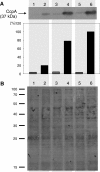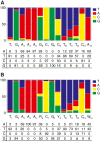High- and low-affinity cre boxes for CcpA binding in Bacillus subtilis revealed by genome-wide analysis
- PMID: 22900538
- PMCID: PMC3463425
- DOI: 10.1186/1471-2164-13-401
High- and low-affinity cre boxes for CcpA binding in Bacillus subtilis revealed by genome-wide analysis
Abstract
Background: In Bacillus subtilis and its relatives carbon catabolite control, a mechanism enabling to reach maximal efficiency of carbon and energy sources metabolism, is achieved by the global regulator CcpA (carbon catabolite protein A). CcpA in a complex with HPr-Ser-P (seryl-phosphorylated form of histidine-containing protein, HPr) binds to operator sites called catabolite responsive elements, cre. Depending on the cre box position relative to the promoter, the CcpA/HPr-Ser-P complex can either act as a positive or a negative regulator. The cre boxes are highly degenerate semi-palindromes with a lowly conserved consensus sequence. So far, studies aimed at revealing how CcpA can bind such diverse sites were focused on the analysis of single cre boxes. In this study, a genome-wide analysis of cre sites was performed in order to identify differences in cre sequence and position, which determine their binding affinity.
Results: The transcriptomes of B. subtilis cultures with three different CcpA expression levels were compared. The higher the amount of CcpA in the cells, the more operons possessing cre sites were differentially regulated. The cre boxes that mediated regulation at low CcpA levels were designated as strong (high affinity) and those which responded only to high amounts of CcpA, as weak (low affinity). Differences in the sequence and position in relation to the transcription start site between strong and weak cre boxes were revealed.
Conclusions: Certain residues at specific positions in the cre box as well as, to a certain extent, a more palindromic nature of cre sequences and the location of cre in close vicinity to the transcription start site contribute to the strength of CcpA-dependent regulation. The main factors contributing to cre regulatory efficiencies, enabling subtle differential control of various subregulons of the CcpA regulon, are identified.
Figures




Similar articles
-
Structures of carbon catabolite protein A-(HPr-Ser46-P) bound to diverse catabolite response element sites reveal the basis for high-affinity binding to degenerate DNA operators.Nucleic Acids Res. 2011 Apr;39(7):2931-42. doi: 10.1093/nar/gkq1177. Epub 2010 Nov 23. Nucleic Acids Res. 2011. PMID: 21106498 Free PMC article.
-
CcpA-mediated catabolite activation of the Bacillus subtilis ilv-leu operon and its negation by either CodY- or TnrA-mediated negative regulation.J Bacteriol. 2014 Nov;196(21):3793-806. doi: 10.1128/JB.02055-14. Epub 2014 Aug 25. J Bacteriol. 2014. PMID: 25157083 Free PMC article.
-
Specific recognition of the Bacillus subtilis gnt cis-acting catabolite-responsive element by a protein complex formed between CcpA and seryl-phosphorylated HPr.Mol Microbiol. 1995 Sep;17(5):953-60. doi: 10.1111/j.1365-2958.1995.mmi_17050953.x. Mol Microbiol. 1995. PMID: 8596444
-
Carbon catabolite control of the metabolic network in Bacillus subtilis.Biosci Biotechnol Biochem. 2009 Feb;73(2):245-59. doi: 10.1271/bbb.80479. Epub 2009 Feb 7. Biosci Biotechnol Biochem. 2009. PMID: 19202299 Review.
-
Catabolite repression in Bacillus subtilis: a global regulatory mechanism for the gram-positive bacteria?Mol Microbiol. 1995 Feb;15(3):395-401. doi: 10.1111/j.1365-2958.1995.tb02252.x. Mol Microbiol. 1995. PMID: 7540244 Review.
Cited by
-
Hydrogen Peroxide Production of Group A Streptococci (GAS) is emm-Type Dependent and Increased at Low Temperatures.Curr Microbiol. 2019 Jun;76(6):698-705. doi: 10.1007/s00284-019-01683-y. Epub 2019 Apr 6. Curr Microbiol. 2019. PMID: 30955044
-
Lactic acid production using cheese whey based medium in a stirred tank reactor by a ccpA mutant of Lacticaseibacillus casei.World J Microbiol Biotechnol. 2021 Mar 15;37(4):61. doi: 10.1007/s11274-021-03028-z. World J Microbiol Biotechnol. 2021. PMID: 33719024
-
An experimentally supported model of the Bacillus subtilis global transcriptional regulatory network.Mol Syst Biol. 2015 Nov 17;11(11):839. doi: 10.15252/msb.20156236. Mol Syst Biol. 2015. PMID: 26577401 Free PMC article.
-
comCDE (Competence) Operon Is Regulated by CcpA in Streptococcus pneumoniae D39.Microbiol Spectr. 2023 Jun 15;11(3):e0001223. doi: 10.1128/spectrum.00012-23. Epub 2023 Apr 10. Microbiol Spectr. 2023. PMID: 37036382 Free PMC article.
-
Citrate Supplementation Modulates Medium Viscosity and Poly-γ-Glutamic Acid Synthesis by Engineered B. subtilis 168.Eng Life Sci. 2025 Mar 4;25(3):e70009. doi: 10.1002/elsc.70009. eCollection 2025 Mar. Eng Life Sci. 2025. PMID: 40046170 Free PMC article.
References
-
- Henkin TM, Grundy FJ, Nicholson WL, Chambliss GH. Catabolite repression of α amylase gene expression in Bacillus subtilis involves a trans‒acting gene product homologous to the Escherichia coli lacl and galR repressors. Mol Microbiol. 1991;5:575–584. doi: 10.1111/j.1365-2958.1991.tb00728.x. - DOI - PubMed
Publication types
MeSH terms
Substances
LinkOut - more resources
Full Text Sources
Other Literature Sources
Molecular Biology Databases

